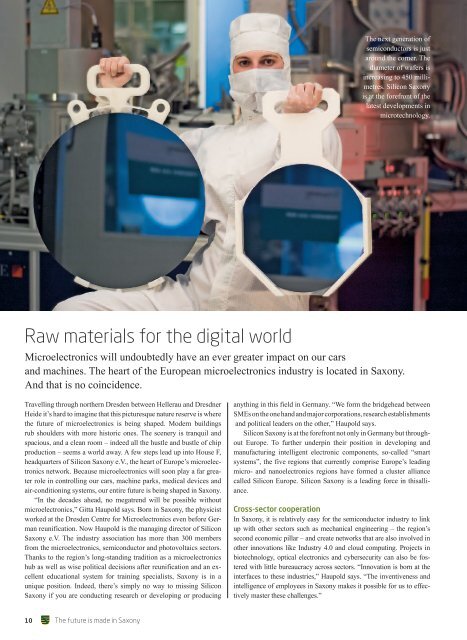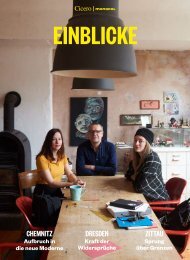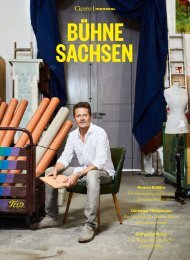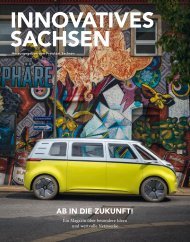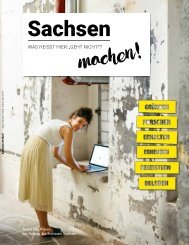The future is made in saxony
A magazine of the Free State of Saxony Autumn/Winter 2014
A magazine of the Free State of Saxony Autumn/Winter 2014
You also want an ePaper? Increase the reach of your titles
YUMPU automatically turns print PDFs into web optimized ePapers that Google loves.
Raw materials for the digital world<br />
Microelectronics will undoubtedly have an ever greater impact on our cars<br />
and mach<strong>in</strong>es. <strong>The</strong> heart of the European microelectronics <strong>in</strong>dustry <strong>is</strong> located <strong>in</strong> Saxony.<br />
And that <strong>is</strong> no co<strong>in</strong>cidence.<br />
Travell<strong>in</strong>g through northern Dresden between Hellerau and Dresdner<br />
Heide it’s hard to imag<strong>in</strong>e that th<strong>is</strong> picturesque nature reserve <strong>is</strong> where<br />
the <strong>future</strong> of microelectronics <strong>is</strong> be<strong>in</strong>g shaped. Modern build<strong>in</strong>gs<br />
rub shoulders with more h<strong>is</strong>toric ones. <strong>The</strong> scenery <strong>is</strong> tranquil and<br />
spacious, and a clean room – <strong>in</strong>deed all the hustle and bustle of chip<br />
production – seems a world away. A few steps lead up <strong>in</strong>to House F,<br />
headquarters of Silicon Saxony e.V., the heart of Europe’s microelectronics<br />
network. Because microelectronics will soon play a far greater<br />
role <strong>in</strong> controll<strong>in</strong>g our cars, mach<strong>in</strong>e parks, medical devices and<br />
air-condition<strong>in</strong>g systems, our entire <strong>future</strong> <strong>is</strong> be<strong>in</strong>g shaped <strong>in</strong> Saxony.<br />
“In the decades ahead, no megatrend will be possible without<br />
microelectronics,” Gitta Haupold says. Born <strong>in</strong> Saxony, the physic<strong>is</strong>t<br />
worked at the Dresden Centre for Microelectronics even before German<br />
reunification. Now Haupold <strong>is</strong> the manag<strong>in</strong>g director of Silicon<br />
Saxony e.V. <strong>The</strong> <strong>in</strong>dustry association has more than 300 members<br />
from the microelectronics, semiconductor and photovoltaics sectors.<br />
Thanks to the region’s long-stand<strong>in</strong>g tradition as a microelectronics<br />
hub as well as w<strong>is</strong>e political dec<strong>is</strong>ions after reunification and an excellent<br />
educational system for tra<strong>in</strong><strong>in</strong>g special<strong>is</strong>ts, Saxony <strong>is</strong> <strong>in</strong> a<br />
unique position. Indeed, there’s simply no way to m<strong>is</strong>s<strong>in</strong>g Silicon<br />
Saxony if you are conduct<strong>in</strong>g research or develop<strong>in</strong>g or produc<strong>in</strong>g<br />
<strong>The</strong> next generation of<br />
semiconductors <strong>is</strong> just<br />
around the corner. <strong>The</strong><br />
diameter of wafers <strong>is</strong><br />
<strong>in</strong>creas<strong>in</strong>g to 450 millimetres.<br />
Silicon Saxony<br />
<strong>is</strong> at the forefront of the<br />
latest developments <strong>in</strong><br />
microtechnology.<br />
anyth<strong>in</strong>g <strong>in</strong> th<strong>is</strong> field <strong>in</strong> Germany. “We form the bridgehead between<br />
SMEs on the one hand and major corporations, research establ<strong>is</strong>hments<br />
and political leaders on the other,” Haupold says.<br />
Silicon Saxony <strong>is</strong> at the forefront not only <strong>in</strong> Germany but throughout<br />
Europe. To further underp<strong>in</strong> their position <strong>in</strong> develop<strong>in</strong>g and<br />
manufactur<strong>in</strong>g <strong>in</strong>telligent electronic components, so-called “smart<br />
systems”, the five regions that currently compr<strong>is</strong>e Europe’s lead<strong>in</strong>g<br />
micro- and nanoelectronics regions have formed a cluster alliance<br />
called Silicon Europe. Silicon Saxony <strong>is</strong> a lead<strong>in</strong>g force <strong>in</strong> th<strong>is</strong>alliance.<br />
Cross-sector cooperation<br />
In Saxony, it <strong>is</strong> relatively easy for the semiconductor <strong>in</strong>dustry to l<strong>in</strong>k<br />
up with other sectors such as mechanical eng<strong>in</strong>eer<strong>in</strong>g – the region’s<br />
second economic pillar – and create networks that are also <strong>in</strong>volved <strong>in</strong><br />
other <strong>in</strong>novations like Industry 4.0 and cloud comput<strong>in</strong>g. Projects <strong>in</strong><br />
biotechnology, optical electronics and cybersecurity can also be fostered<br />
with little bureaucracy across sectors. “Innovation <strong>is</strong> born at the<br />
<strong>in</strong>terfaces to these <strong>in</strong>dustries,” Haupold says. “<strong>The</strong> <strong>in</strong>ventiveness and<br />
<strong>in</strong>telligence of employees <strong>in</strong> Saxony makes it possible for us to effectively<br />
master these challenges.”<br />
<strong>The</strong> lab <strong>in</strong> a chip card<br />
BiFlow Systems <strong>in</strong> Chemnitz has managed<br />
to shr<strong>in</strong>k a central laboratory to the size of a<br />
chip card, enabl<strong>in</strong>g life-sav<strong>in</strong>g analyses to be<br />
performed worldwide <strong>in</strong> just seconds.<br />
<strong>The</strong> BiFlow System’s medical chip card <strong>is</strong> dark green like an ord<strong>in</strong>ary<br />
circuit board and not much larger than a cereal bar. As a result,<br />
it doesn’t seem particularly spectacular. But appearances can deceive.<br />
<strong>The</strong> chip card essentially conta<strong>in</strong>s an entire medical laboratory. T<strong>in</strong>y<br />
fluid chambers that can each hold a little more than a ra<strong>in</strong>drop are connected<br />
to a m<strong>in</strong>iature pump that transports the fluid to a chip fitted with<br />
biosensors. It can test blood, saliva or water for d<strong>is</strong>eases with<strong>in</strong> seconds.<br />
“Once the chip card <strong>is</strong> filled, it <strong>is</strong> simply slotted <strong>in</strong>to the reader,<br />
which immediately provides an answer,” expla<strong>in</strong>s BiFlow Manag<strong>in</strong>g<br />
Director Jörg Nestler.<br />
That means no more wait<strong>in</strong>g around days for results. Better still: If<br />
doctors and patients react more quickly, epidemics and similar problems<br />
can be controlled far more easily.<br />
Home health checks<br />
BiFlow technology will probably also be shap<strong>in</strong>g the <strong>future</strong> <strong>in</strong> <strong>in</strong>dustrial<strong>is</strong>ed<br />
nations, where health monitor<strong>in</strong>g will no longer be restricted<br />
to a few factors like blood pressure and blood sugar levels. “It’s not<br />
restricted to humans either,” Nestler adds. “<strong>The</strong> systems can also be<br />
used <strong>in</strong> veter<strong>in</strong>ary medic<strong>in</strong>e and for environmental analyses.” <strong>The</strong> system<br />
was <strong>in</strong>vented by Nestler himself, who conducted research and<br />
completed h<strong>is</strong> PhD at Chemnitz University of Applied Science. He<br />
founded BiFlow Systems to commercial<strong>is</strong>e h<strong>is</strong> <strong>in</strong>vention. Its location<br />
Lots of heat for little money<br />
Heat<strong>in</strong>g and cool<strong>in</strong>g residential build<strong>in</strong>gs<br />
consumes a lot of energy. <strong>The</strong> company Wätas<br />
ensures that every build<strong>in</strong>g has the right temperature<br />
with m<strong>in</strong>imum energy consumption.<br />
When <strong>is</strong> a beer crate not a beer crate? Wätas heat exchangers<br />
can be concealed beh<strong>in</strong>d the most unusual covers.<br />
<strong>The</strong> chip card developed by Jörg Nestler and h<strong>is</strong> team enables<br />
liquids to be analysed <strong>in</strong> seconds.<br />
on the Smart Systems Campus <strong>in</strong> Chemnitz enables the company to<br />
exchange special<strong>is</strong>t knowledge with other start-ups and establ<strong>is</strong>hed<br />
research centres like the university and nearby Fraunhofer <strong>in</strong>stitutes.<br />
Nestler’s “former” university colleagues also provide new f<strong>in</strong>d<strong>in</strong>gs<br />
from their research. Automated production of the chips <strong>is</strong> due to start<br />
soon – <strong>in</strong> the start-up build<strong>in</strong>g on the campus, too, of course.<br />
“Preserv<strong>in</strong>g resources and renewable energy are d<strong>is</strong>cussed every day,”<br />
says Wätas Manag<strong>in</strong>g Director Torsten Enders. Wätas has developed a<br />
new technology that saves energy, thereby also cutt<strong>in</strong>g costs. Whereas<br />
conventional boilers require high flow temperatures of 50 degrees<br />
Celsius or more to ma<strong>in</strong>ta<strong>in</strong> room temperature at a constant 24 degrees<br />
Celsius, Wätas’ device requires a flow temperature of only 35 degrees<br />
Celsius. “Every degree we can lower the flow temperature cuts energy<br />
consumption by 2 per cent,” Enders says. “All you need to do <strong>is</strong> <strong>in</strong>crease<br />
the transfer surface for the energy.”<br />
What makes th<strong>is</strong> possible <strong>is</strong> a f<strong>in</strong> coil heat exchanger work<strong>in</strong>g <strong>in</strong><br />
conjunction with both standard radiators and entire walls that turn <strong>in</strong>to<br />
heated surfaces. <strong>The</strong>se heat exchangers can also be <strong>in</strong>stalled <strong>in</strong> mach<strong>in</strong>es<br />
to use their waste heat for heat<strong>in</strong>g purposes.<br />
Energy costs will be dec<strong>is</strong>ive<br />
Wätas <strong>is</strong> conv<strong>in</strong>ced that <strong>in</strong> <strong>future</strong> the cost of energy, not materials,<br />
will be essential for determ<strong>in</strong><strong>in</strong>g the price at which a product can be<br />
sold. Th<strong>is</strong> <strong>is</strong> why Wätas wants to have the technology solution <strong>in</strong> its<br />
hands. Wätas benefits primarily from the strong technological expert<strong>is</strong>e<br />
of the region’s employees, not least because its first special<strong>is</strong>ts<br />
were part of the former workforce of East German refrigerator manufacturer<br />
Foron which produced its goods <strong>in</strong> the region.<br />
10 <strong>The</strong> <strong>future</strong> <strong>is</strong> <strong>made</strong> <strong>in</strong> Saxony <strong>The</strong> <strong>future</strong> <strong>is</strong> <strong>made</strong> <strong>in</strong> Saxony 11


